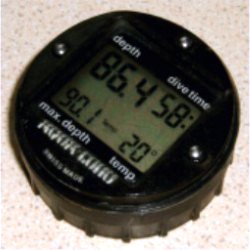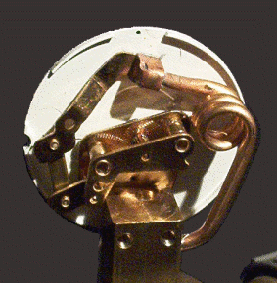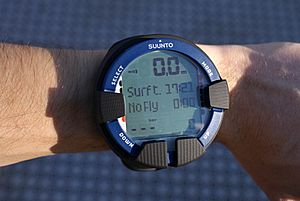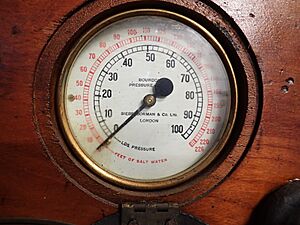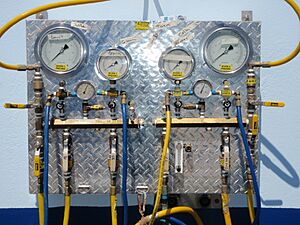Depth gauge facts for kids
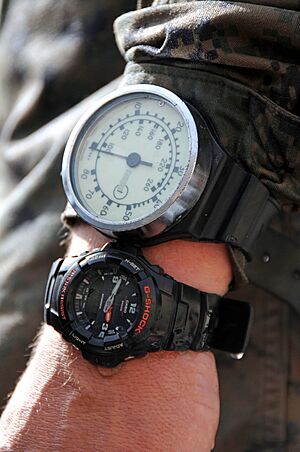
US Marine diver with a diving watch and an analog depth gauge
|
A depth gauge is a tool that measures how deep something is underwater. Divers, submarines, and underwater robots use them. It's like a special pressure gauge that shows depth by measuring water pressure.
Most modern depth gauges for divers are electronic and have a digital screen. Older ones used mechanical parts and a needle display. Digital depth gauges often include a timer. This timer shows how long a diver has been underwater. Some also show how fast a diver is going up or down. This helps divers avoid health problems from changing pressure too quickly. A combined depth gauge and timer is sometimes called a bottom timer. Electronic depth gauges are a key part of a dive computer.
Depth gauges measure water pressure. Because of this, the depth they show can be slightly off. This happens when they are used in both fresh water and salt water. Salt water is heavier than fresh water, so the pressure changes differently.
A special type of depth gauge is called a pneumofathometer. It measures depth by checking the pressure of air bubbling out of a hose.
Contents
History of Depth Gauges
Scientists have been interested in measuring depth for a long time. In 1659, Robert Boyle experimented with a barometer underwater. This led to Boyle's law, which explains how gas pressure changes with volume.
In 1695, Denis Papin, a French inventor, suggested using a depth gauge for a submarine. The first time a depth gauge was actually used in an underwater craft was in 1775. This was for David Bushnell's submarine, the Turtle. The gauge was made by Isaac Doolittle. By the early 1800s, depth gauges were a common feature on diving bells.
How Depth Gauges Work
As you go deeper in water, the pressure increases. For every 10 meters (about 33 feet) you go down in fresh water, the pressure goes up by about 1 bar. So, a depth gauge figures out your depth by measuring this pressure. Then, it compares it to the pressure at the surface.
The air pressure at the surface can change with weather or altitude. For very accurate readings, a depth gauge should be set for the local air pressure. Also, water density changes with temperature and saltiness. This means that for super-accurate depth, you would need to know the water's temperature and saltiness.
Different Kinds of Depth Gauges
Capillary Depth Gauge
The capillary depth gauge is a simple type. It's a clear tube open at one end. When you dive, water goes into the tube and squeezes an air bubble inside. The size of the air bubble shows the depth on a scale.
This gauge works well for shallow depths, up to about 10 meters (33 feet). At these depths, the pressure doubles, making the scale easy to read. But it becomes less accurate in deeper water. It also can't record the deepest point you reached. Temperature changes can also affect its accuracy.
Bourdon Tube Depth Gauge
The Bourdon tube depth gauge uses a curved metal tube. Water pressure makes this tube straighten out a little. When the pressure goes down, the tube curves back. This small movement is connected to a pointer by gears or levers.
The pointer can have a second, "trailing" pointer. This second pointer stays at the deepest point reached, even if the main pointer moves back up. These gauges can be quite accurate. However, temperature changes can affect them because they measure the pressure difference between the water and the air inside the gauge.
Membrane Depth Gauge
In a membrane depth gauge, water pushes on a flexible metal part called a membrane. The membrane bends based on the outside pressure. This bending is then magnified by levers and gears to move a pointer. Like the Bourdon tube gauge, it can have a trailing pointer to show maximum depth. These gauges can be very accurate if they are adjusted for temperature changes.
Some membrane gauges use Strain gauges. These turn the pressure on the membrane into an electrical signal. This signal can then be processed and shown as a digital depth reading.
Piezoresistive Pressure Sensors
These sensors are very common in modern dive computers. They use a special material, usually silicon, that changes its electrical resistance when pressure is applied. A silicon membrane with tiny resistors built into it bends under pressure. This changes the resistance, which is then converted into a depth reading. These sensors also need to be adjusted for temperature changes to be accurate.
Pneumofathometer
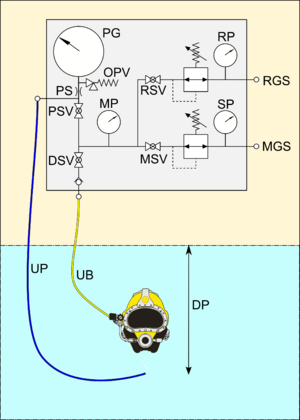
A pneumofathometer measures the depth of a diver who gets air from the surface. It works by measuring the pressure of a small amount of air that bubbles out of a special hose connected to the diver. This hose is called a "pneumo line."
These gauges are usually found on the air supply panel at the surface. Divers can also use the pneumo line as an emergency air supply if needed. A special valve called a "gauge snubber" protects the delicate gauge from sudden pressure changes.
Dive Computers
Most dive computers have a depth gauge built right in. The depth reading is digital and is used by the computer to figure out a diver's decompression status. This helps divers avoid getting sick from pressure changes.
The dive computer shows the current depth on its screen. It also records the depth to keep track of the diver's dive profile. Most dive computers use piezoresistive pressure sensors.
Uses of Depth Gauges
Divers use a depth gauge along with decompression tables and a watch. This helps them plan their dives safely and avoid decompression sickness. A popular alternative is a dive computer. It has a depth gauge built-in and automatically calculates safe dive times and depths.
See also
- Altimeter
- Bathometer
- Bathymetry
- Depth sounding


